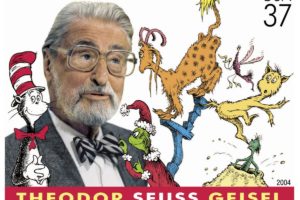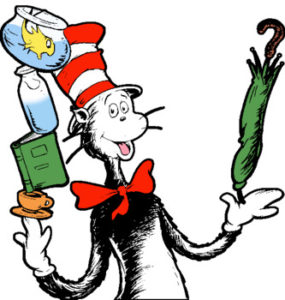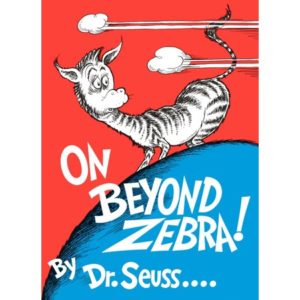
A wonderful tradition began in our childhoods, which was passed on to our children, and then our grandchildren. It was reading the books and savoring the included illustrations of one Theodor Seuss Geisel, aka Dr. Seuss.
What Baby Boomer out there doesn’t have among their earliest childhood recollections reading about Sam I Am, Horton the elephant, the Grinch, and, of course, the Cat in the Hat?
Dr. Seuss was a gifted writer in the minimalist style of Ernest Hemingway. However, he took it to an even more basic level. He felt like children learning to read should concentrate on a few basic words, and wrote wonderful stories using only those selected ones.
For example, legend has it that Green Eggs and Ham was written as a response to a bet proposed by Bennet Cerf that he couldn’t write a book with only fifty different words. Count the words yourself, he pulled it off, and created one of our favorite childhood memories in the process.

But it was Seuss’s illustrations that captivated me. He drew exotic landscapes of roads and tree branches populated by endless varieties of creatures with a distinct look that can only be described as Seussian. His illustrations conveyed happiness. They were reassuring to a kid who might otherwise be having a bad day.
Seuss began as a freelance writer, producing humorous articles and illustrations that were published by the likes of Saturday Evening Post, Life, and Vanity Fair. As WWII began, he began producing political cartoons. He took a hard line against Japanese-Americans in particular, a seemingly paradoxical view for a beloved producer of children’s books.
Speaking of which, his first was published in 1937: And to Think I Saw It on Mulberry Street. It was a success, but only after being rejected by 28 publishers. Imagine if he’d given up, the world might never have known the Cat in the Hat.
His next book was Horton Hatches the Egg, which teaches kids the importance of sticking with what you know is right, perhaps an allusion to the difficulty he had getting his first book published.
Seuss produced books every few years after that before his prolific period of the mid to late 50’s, just in time for the largest generation of kids the world has ever known. My personal favorite, On Beyond Zebra, was penned in 1955. In it, he invented an extended alphabet which stretched on beyond z, with an appropriate fantasy creature to illustrate each letter’s usage. For instance, the letter “floob” is used to spell floobooberbabooberbubs, large serene heads that float in the water.

The Grinch and the Cat in the Hat appeared in 1957, Yertle the Turtle in 1958, and Sam I Am in 1960. After that, Seuss’s output slowed just a bit, but he still gave us Hop on Pop in 1963, Fox in Socks in 1965, and the Lorax in 1971. The latter book was banned from some schools because of its anti-forestry stance.
Seuss’s last book is considered by many to be his finest: Oh, the Places You’ll Go! Penned in 1990, it was a manual for kids on how to handle life’s challenges. While aimed at children, it has proven to be a popular high school and college graduation gift.
Seuss’s legacy lives on. Grade school libraries are still loaded with his work. When my kids were small in the 90’s, we bought Seuss books for them. And no doubt, my grandkids will love them too, when they get here.
How fortunate we are that this beloved author-illustrator stubbornly insisted on sharing his talent for reaching kids with the rest of the world.
And now, six of his books have been banned for being “racist.”